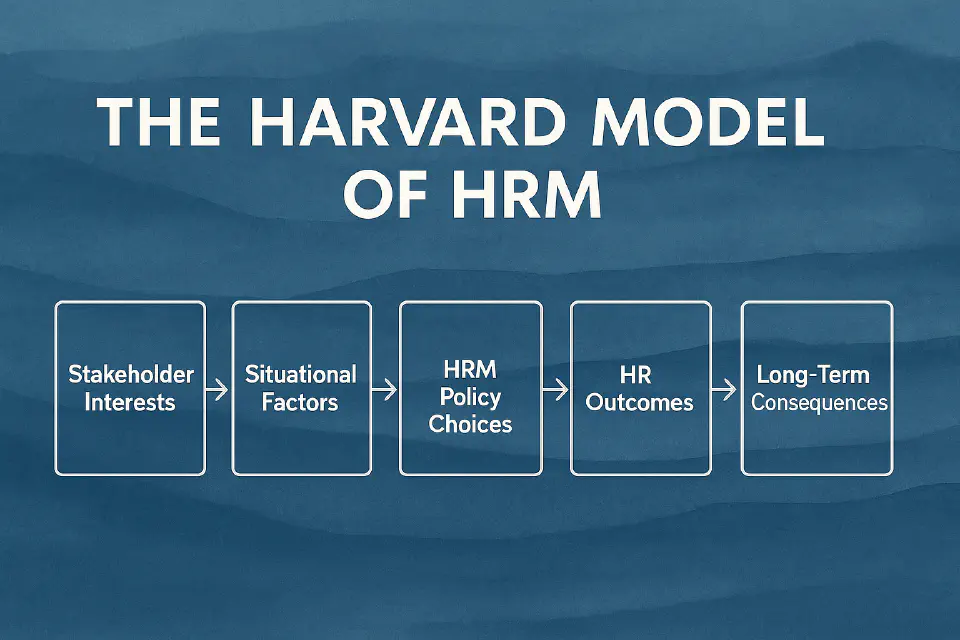
The Harvard Model of HRM
The Harvard Model changed the way we think about HR. It reframed people as stakeholders, not resources—and connected HR outcomes with long-term success.
The Harvard Model of Human Resource Management, developed in the early 1980s by Beer et al., represents a foundational shift in how organizations understand and manage people. Unlike earlier models that treated employees as costs or production inputs, the Harvard Model positioned them as stakeholders—central to both performance and ethical responsibility.
It offered a comprehensive framework for aligning HR practices with long-term organizational goals, while also considering societal expectations and employee well-being.
Origins and Theoretical Basis
The model emerged in response to the limitations of traditional personnel management and overly mechanistic views of human behavior. Drawing on systems theory, behavioral science, and stakeholder theory, the Harvard Model proposed that HRM should be about more than just efficiency.
It was one of the first models to define HRM as both a strategic and moral activity—not only about driving results, but about doing so in a way that respects human dignity and organizational responsibility.
Core Components of the Harvard Model
The framework consists of five interrelated components:
Stakeholder Interests
Includes shareholders, employees, unions, managers, government, and community. HRM must balance these competing interests rather than serve only management goals.Situational Factors
Such as labor markets, laws, business strategy, and workforce characteristics. These determine the context in which HRM operates.HRM Policy Choices
The organization’s stance on areas like employee influence, reward systems, work systems, and human resource flows (recruitment, promotion, etc.).HR Outcomes
Including commitment, competence, congruence (alignment with values), and cost-effectiveness. These are the levers through which HR adds value.Long-Term Consequences
For individuals (well-being), the organization (productivity and innovation), and society (compliance, trust, sustainability).
Human-Centered Assumptions
The Harvard Model assumes that:
- Employees are capable of development and deserve involvement.
- HR policies must align with organizational values and strategy.
- Organizations bear responsibility beyond economic outcomes—they shape culture, ethics, and citizenship.
This positions HR as a moral agent, not just a technical function.
Practical Applications
While developed as an academic framework, the Harvard Model has deeply influenced practice:
- Employee Voice: Encouraging consultation, co-creation, and representation in policy design.
- Values-Driven Strategy: Building HR systems that reflect organizational mission and culture.
- Long-Term Thinking: Focusing on sustainability, retention, and capability development rather than short-term metrics.
Strengths of the Harvard Model
- Integrative: Links internal and external factors, values, and strategy.
- Flexible: Can be adapted to diverse sectors and organizational types.
- Ethical: Builds fairness and accountability into the core of HRM.
Criticisms and Limitations
- Complexity: Its broad scope can be hard to implement in practice.
- Idealism: Assumes managers have time, skills, and incentives to balance stakeholder needs.
- Underplays Power Dynamics: Doesn’t always account for internal politics or structural inequalities.
Link to Strategic HRM
The Harvard Model laid the groundwork for Strategic HRM by:
- Framing HR as a system, not a set of tasks
- Emphasizing alignment with business strategy
- Highlighting the impact of HR on long-term performance
It remains a foundational reference in academic literature and executive education alike.
Conclusion
The Harvard Model was revolutionary for its time—and still relevant today. It reminded organizations that people are not just inputs, but partners in purpose. In a world of increasing complexity and expectation, its call for balance, responsibility, and long-term thinking in HR is more vital than ever.
Understanding this model helps HR professionals lead not just with efficiency—but with integrity.